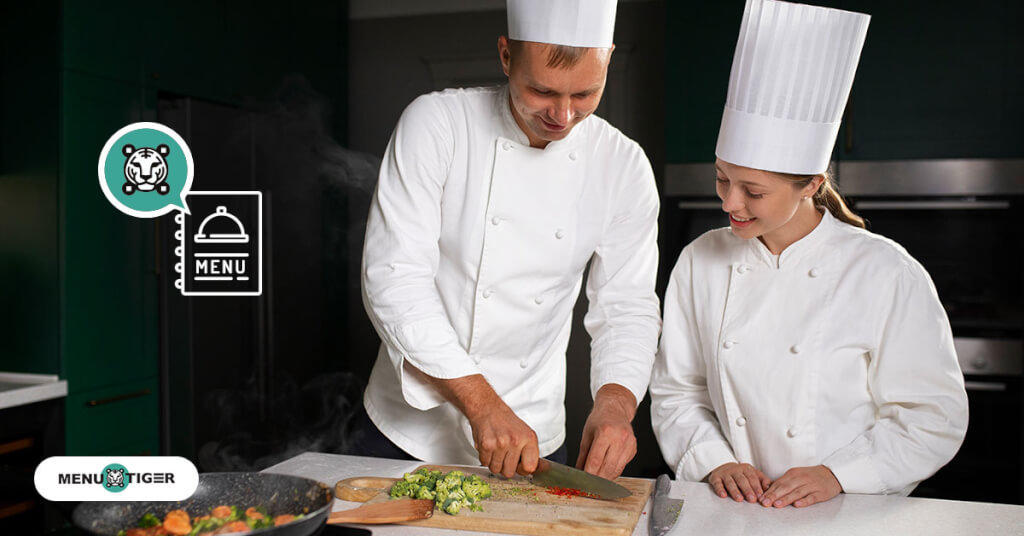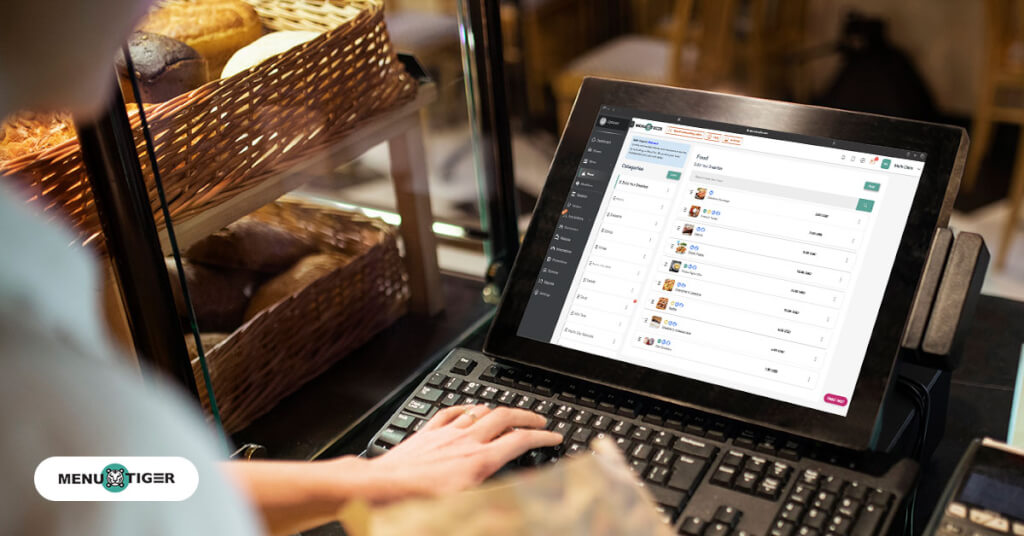
10-Step Guide To Opening a Restaurant
Last Updated: October 8, 2025
The first step is always the hardest, especially when starting a food business. But don’t worry; we’ll share with you our user-friendly guide to opening a restaurant to help you out.
With meticulous planning, a compelling vision, and a thorough understanding of the sector, you can navigate the ever-changing landscape and thrive as a restaurant owner.
Embrace the opportunities to cater to diverse consumer demands, create an inviting atmosphere, manage finances, hire and train staff, and market your restaurant effectively.
And with MENU TIGER’s innovative QR code menu software, you can operate your business more smoothly. This intuitive technology can help you guarantee your customers’ satisfaction with your food, service, and overall experience.
Essential steps to open a restaurant

A guide on how to start a restaurant takes precise attention to detail, like choosing the best QR code menu software and in-depth industry knowledge. You must understand the key steps in bringing your culinary vision to life to guarantee its success.
So, what does it take to open a restaurant? We have gathered critical steps from experts and famous restaurant books for you to begin your exciting journey as an entrepreneur.
Define the business concept
A distinct vision for your company is necessary when conceptualizing a new restaurant. This includes the target market, ambiance, food, and unique selling points.
You can launch a restaurant by combining your expertise and passion. There are so many different cultures and cuisines you can draw inspiration from, but focus on what you do well and what sets you apart from other restaurants.
Keep in mind that your restaurant concept needs to be genuine, distinct, and customized to your passion and target market.
Take your time when establishing the business; this will create a successful and enjoyable dining experience for your target demographic.
Create a well-curated menu
Actively collaborate with talented chefs and culinary professionals to create a well-curated menu. Make sure to have a menu that reflects your concept and resonates with your target market.
Develop recipes that showcase your unique vision while considering your customers' preferences. Emphasize using high-quality ingredients sourced from trusted local suppliers to ensure freshness and support the community.
Embrace technology to enhance your menu offerings. One popular option is incorporating menu QR codes to provide a seamless and interactive dining experience.
This modern approach adds convenience and efficiency while reducing physical contact, making it more appealing in the current climate.
When crafting your menu, consider putting dietary restrictions and preferences—this ensures you have options for various needs, such as vegetarian, vegan, or gluten-free.
Consider the seasonality of ingredients to showcase the freshest flavors and capitalize on what nature offers.
This enhances the dining experience and demonstrates your commitment to sustainability.
Conduct market research
This step is essential in how to start a restaurant as it involves gathering and analyzing data to understand the local dining landscape and the target audience, competition, and market trends.
To do so, you must first determine the specific goals of your market research. This includes the demand assessment of a particular cuisine.
You must also identify your target demographic—whether local or psychographics of your target audience.
Identify the direct and indirect competitors in your area. Visit their establishments to review their comprehensive menus and check out their menu pricing, ambiance, and their quality of service.
You should also know your competitors’ strengths and weaknesses, unique selling points, and customer reviews.
Stay on top of marketing trends, evaluate restaurant location feasibility, and analyze online reviews and interviews to grasp your target audience's preferences.
Doing these will make you prepared to adapt to changes in the industry.
Develop a comprehensive business plan
Describe your concept, target market, menu, pricing, marketing, financial projections, and other operational aspects in a business plan.
You can develop an executive summary that gives a general description of your restaurant concept. Include the restaurant’s mission statement, vision, and unique selling point.
Also include key details about your business, such as its location, ownership information, and legal structure.
Describe the marketing and sales plans you have in place to draw in and keep clients.
For instance, you can replace printed menus with a smart QR code menu software. This will allow you to serve customers effortlessly through contactless transactions.
This will serve as your road map for your business venture, directing your choices and laying the groundwork for your restaurant's success. You must guarantee it’s accurate, organized, and well-prepared.
Determine the financial costs
Starting a restaurant comes with a price, which is why you must calculate your budget and expenses carefully, considering various criteria in the process.
You must be aware of your restaurant's setup and continuing costs. Among your alternatives for financing are personal savings, bank loans, partnerships, and looking for investor capital.
However, you still need to create a thorough financial strategy, especially when adding tax rates to menu prices; you should get assistance from financial advisors.
For smarter financial planning, consider AI-powered real-time company valuations from Eqvista, helping founders and restaurant owners alike understand their true business value when raising capital or attracting investors.
You can also conduct extensive investigations to obtain cost estimates from your suppliers, equipment vendors, contractors, and consultants. Take into account the price of insurance, permit and license fees, and marketing charges.
Add to that the price of the rental or lease, remodeling, decorating, the first stock of goods, marketing, advertising, hiring, and training.
A contingency fund should also be set up to cover unforeseen costs or delays. Ensure that you have enough working capital to meet startup expenses.
Consider including funds in your budget for hiring consultants, accountants, and attorneys to help you with financial planning, operational guidance, and legal obligations.
Review and revise your budget frequently as you gather more precise accounts and data. This will assist you in modifying your ideas to fit your financial budget.
It’s always better to be prepared, so having a reserve of money to cover unforeseen expenses is also advised.
Choose a suitable location
Consider your target market's preferences when deciding where to locate your restaurant.
Do an in-depth look into the population demographic, income levels of households, quality of life, and culinary tastes of the area.
Locate your business in areas with much foot traffic to attract potential clients.
Consider locations close to well-known attractions, malls, business districts, or residential neighborhoods as a recommendation. Just ensure your restaurant has clear signs and is visible from the street.
Obtain permits and licenses
Your restaurant must follow the rules and regulations set by the local government in your area, and securing permits and licenses guarantees that you do.
However, consider that these permits and licenses vary depending on where you are and what kind of restaurant you own.
Start by learning more about the particular permits and licenses your city or municipality needs for restaurants.
Contact the regional government offices that handle business registration, health, food service, building codes, and other licenses and permits.
Seek health department permits at your neighborhood health departments. This guarantees all the required licenses, including your food service license and health and safety requirements.
Apply for legal entity status for your restaurant with the relevant government body. As a result, it must be registered as a corporation, partnership, limited liability company (LLC), or sole proprietorship.
To make sure legal documents and compliance notices are efficiently managed, it is imperative that you appoint a Texas Registered Agent if you choose to form an LLC. In addition to simplifying the process, this step allows you to meet state requirements while focusing on your restaurant operations.
To protect personal assets from business liabilities and gain tax flexibility, registering as a Limited Liability Company (LLC) is a smart choice. Since the LLC formation process can be complex, hiring a registered agent service can simplify the process, ensuring a smooth setup and accurate decision-making.
Speak with a company attorney or accountant to identify the best structure and plans for your restaurant.
Craft an inviting space
This guide to opening a restaurant won’t be complete without creating a comfortable yet classy atmosphere for your restaurant.
Your layout must have an enticing and practical design. Plan the interior decor, arrangement of furnishings, kitchen design, and general atmosphere with the help of designers or architects.
To create a special eating experience, consider branding, decor, lighting, and furniture choices–this can serve as your simple
Depending on your preferences, you can alter the ambiance of your restaurant to create either a warm, intimate setting or a lively, active one.
Select background music that goes well with your notion. Your establishment will have a pleasant atmosphere as a result. Additionally, consider the noise levels to ensure they improve the dining experience without stifling a conversation.
You can use this restaurant-themed Spotify playlist to set the mood of your establishment if you'd like. Add aromatics like fresh flowers or aromatic candles to amplify a pleasing scent inside your organization.
Keep in mind that constructing a welcoming restaurant involves more than just the building itself. It is about giving your visitors outstanding service, delicious food, and an unforgettable experience.
To ensure your restaurant stays welcoming and appealing to your target demographic, ask for client input frequently and make the required improvements.
Source equipment and supplies
Purchase or rent the supplies, furniture, fixtures, and culinary equipment your restaurant will need. Ensure you have all the tools necessary for meal preparation, cooking, storage, and serving.
Ensure you have a thorough list of the materials and equipment your restaurant will need. They can be divided into furniture, tabletop goods, kitchenware, cleaning supplies, and other operational essentials.
Conduct in-depth research to find possible providers of these goods. Find vendors who specialize in providing supplies and equipment for restaurants. Search online directories, trade magazines, and industry forums to find these experts.
You can also go to trade events and expos to find suppliers in person. With this approach, you can negotiate deals and analyze things for yourself.
Recruit and train staff
Hire and train competent employees for your restaurant, including chefs, cooks, servers, bartenders, hosts, and managerial staff. This unified and competent staff can support your company in providing outstanding services to your target customers.
To hire the ideal individuals for your restaurant, list the essential duties and qualities you want them to possess.
After completing the hiring process, provide your chosen individuals with a thorough orientation and onboarding procedure. Introduce your standards, beliefs, and expectations to these people.
Ensure the staff knows your menus, service expectations, and restaurant training manual.
Establish a positive and welcoming work atmosphere to promote cooperation, communication, and respect among coworkers.
Encourage open communication among your staff. To strengthen your relationship with your staff, you should also acknowledge and reward great achievements in your company.
Putting time and effort into hiring the best people for your company is crucial, especially if you are being mindful of the restaurant employment statistics. Foster their professional development and ensure your company's success in the market by giving them adequate training.

What does it take to open a restaurant?
Opening a restaurant requires a combination of passion, careful planning, and a strong business mindset.
It involves more than just serving delicious food—it requires strategic decision-making, effective management, and a memorable dining experience.
By understanding the intricacies of the restaurant industry and taking proactive steps to open a restaurant, you can set yourself up for success in this competitive and ever-evolving field.
Pre-opening marketing
Before your restaurant officially opens its doors, it’s time to generate some excitement and create a buzz that will have people eagerly waiting to experience your culinary delights.
With a well-crafted marketing strategy, you can build your brand, establish a strong social media presence, develop an enticing website, implement local advertising tactics, and engage in effective public relations efforts.
These efforts will not only create anticipation but also connect with potential customers, igniting their curiosity and enthusiasm.
So prepare to embark on a fun-filled adventure, spreading the word about your upcoming restaurant and building a vibrant community of eager food enthusiasts.
Get ready to make a splash and leave a lasting impression as you bring your culinary vision to life.
Grand opening and operations
It’s time to open your kitchen doors and serve customers with your culinary prowess! Plan a spectacular grand opening event to introduce your restaurant to the world.
Once open, focus on wowing customers with exceptional service and mouth-watering dishes. Moreover, keep your inventory in check, control costs, and stay ahead of industry trends.
As one of the tips to opening a restaurant, accept feedback, make adjustments, and keep improving your processes. Brace yourself for a thrilling voyage full of taste, amusement, and limitless opportunities.
Embrace technology
Time to embrace the power of technology! Implement restaurant management software, reservation systems, payment integrations, and point-of-sale systems to bring efficiency and ease to your operations.
With the help of these digital tools, you’ll streamline processes, boost productivity, and create a delightful customer experience.
But wait, there’s more! Integrate a QR code menu software, like MENU TIGER, into your restaurant to add an extra touch of convenience and excitement.
Customers can simply scan the QR code, explore your menu with their smartphones, and order with ease.
It’s a modern twist that will leave them impressed and eager to indulge in your culinary creations.
QR code menu: An essential tool for restaurant startups

Now that we’ve gone through the opening-a-restaurant checklist to ensure that your restaurant is a success, it is time to introduce MENU TIGER, a digital menu software made just for you.
MENU TIGER is your companion when seeking seamless menu management. With this remarkable QR code contactless digital menu software, you’ll enjoy a range of impeccable features designed to simplify your operations and amplify your success.
Easy menu customization
Effortlessly manage your menu’s availability and customize items with ease. No matter where you are, MENU TIGER’s user-friendly platform ensures you have complete control over your menu anytime from any device.
It allows you to go all out when considering the art of menu design because MENU TIGER offers you a wide range of customization tools for your website, menu, and menu QR codes.
Marketing boost
Boost your sales and promotions like never before with powerful marketing tools at your fingertips.
Upsell, cross-sell, and run multiple promotions on your website, all while featuring high-profit margin items that make your offerings shine.
Customizable QR codes
We understand the importance of brand identity, which is why MENU TIGER allows you to customize a menu QR code and website URL QR code.
Choose colors, patterns, and eye-catching frames, and add your store’s logo to captivate your customers and create a lasting impression.
Printer integration
And that’s not all! MENU TIGER seamlessly integrates with printers, automating and speeding up the process of printing menu receipts.
With an affordable add-on feature, you can enjoy this time-saving convenience for just 20 USD per month with our paid plans.
Other key features:
- Canva and Zapier integrations
- Stripe, PayPal, Google Pay, and Apple Pay mobile payment integrations
- Customer feedback
- Supports multi-location stores
- White-label domains
- Order, revenue, and customer analytics
- Customizable restaurant website
- Easily add taxes on menu prices
- No app download
- 24-hour customer support
Check out this comprehensive guide to a restaurant order system using MENU TIGER.

Unlock the recipe for success: Seamlessly start your business with this guide to opening a restaurant
Despite the obstacles, the restaurant industry offers an adventure filled with opportunities for growth and success. This adventure made the industry resilient, adaptable, and technology-savvy.
Now is the time to reimagine your business and find creative solutions to cater to diverse consumer demands.
And the secret ingredient to take your restaurant to new heights is MENU TIGER. With its cutting-edge features and seamless integration, this software will elevate your QR code menu management, streamline operations, and enhance the overall dining experience.
Take the leap, embrace the challenges, and build a thriving restaurant that stands out. Prepare to embark on a culinary adventure with MENU TIGER, which will remain in the hearts and palates of every diner.
Claire
Claire, with two years of writing experience and a deep love for the restaurant industry, seamlessly blends creativity and SEO skills, utilizing her MENU TIGER expertise to create content that pleases both readers and search algorithms.


